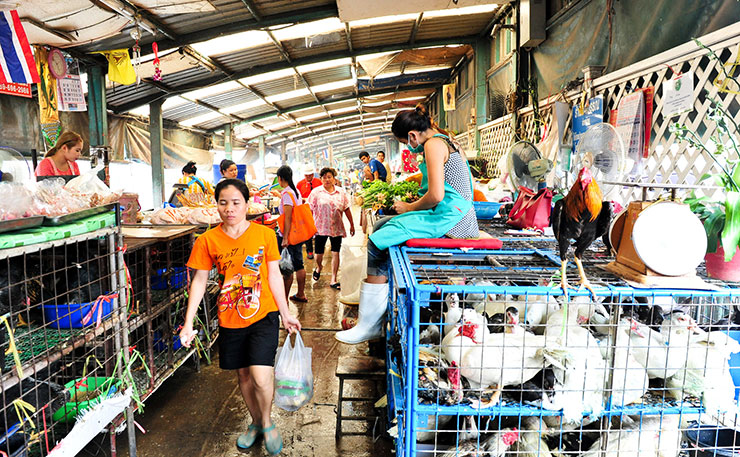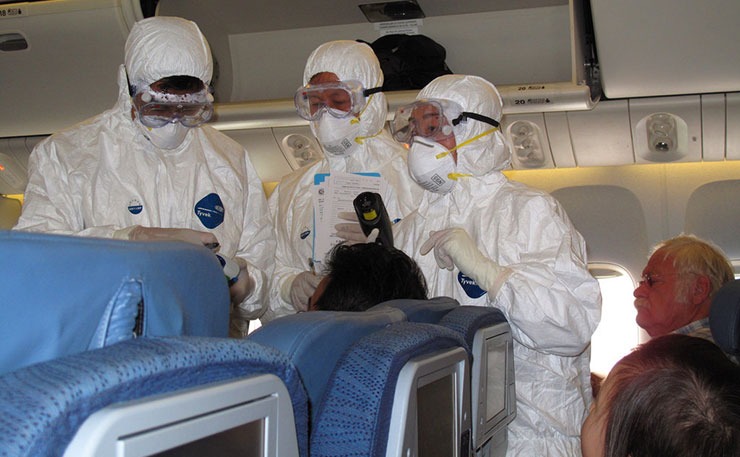If treating animals humanely isn’t enough to motivate you, then the diseases they may give you in return should be, writes Geoff Russell.
Who remembers the 1997 bird flu panic? The H5N1 avian influenza virus gained some random mutation which allowed it to infect people as well as chickens and both started dying in Hong Kong. Luckily for us, the virus didn’t master spreading between people, you had to catch it from a chicken.
The wet markets in Hong Kong at the time were perfect for spreading the disease. A wet market is where people select birds which are killed on the spot. It’s perfect for transmission.
Lots of people in intimate contact with lots of stressed birds and bird parts; blood and guts and respiratory fluids. The stress of the situation depresses the birds’ immune systems making them more prone to getting sick and being close to people helps the disease spread.
It wasn’t just wet markets causing problems, cock fighting played a role also. Handlers like to keep their birds throats clear of mucus to aid breathing. How? They suck it out. The ingenuity of animal abusers never ceases to amaze me. Karma is a junk concept, but the deaths of some of these cock handlers, and their children, was very real.
Well, bird flu is back in the news. Not that it ever really left for those who’ve been paying attention.
This time it isn’t H5N1, but H7N9 and the meat industry is reporting that it killed some 79 people in China in February. It’s not coming from wet markets but the gigantic Chinese hen and chicken factory farming cages and sheds. The WHO is yet to confirm the deaths.

But H7N9 is just one of an alphabet soup of deadly influenza viruses causing considerable grief in the global chicken industry at present. Most of them are currently only deadly to chickens, but nobody can predict virus behaviour enough to know when that will change. A modern factory chicken farm is the perfect bioreactor to breed new and deadly viral diseases and that’s exactly what they are doing.
Across the planet there are now billions of birds in close confinement and this is perfect for breeding new diseases. Caged hens for eggs are bad enough, but the chicken meat industry is even worse. The chickens grown by this industry are fundamentally Frankenstinian.
They are bred to grow like crazy for about 6 weeks; and totally incapable of living for the normal chicken lifespan of a decade or more. Less than 3 percent can walk normally by the tender age of 6 weeks, when they are killed. They are all dying well before they are hooked by the feet onto the shackling line.
And globalisation is helping to spread the pain. Greece is currently seeing its first culling of sheds hit by H5N6. This was previously only seen in Asia.
The US is being hit with a not yet fully characterised H7 virus in Tennessee. This has seen South Korea, Hong Kong, Taiwan and Japan all restricting imports of US egg and chicken products.
A recent review of the epidemic potential of viruses contracted from animals found 37 of concern. This was because they can already kill or cause serious disease in humans. Even single mutations can make huge differences to a virus’s impact.
Typically a virus goes from simply infecting one species to infecting another in four stages, but occasionally they just spring fully formed as an efficient killer, seemingly in one jump.
SARS did this in 2003, coming out of bats and killing 774 people in 37 countries. Many of those killed were front line doctors in close contact with patients having a new disease that took some time to understand.

Doctors testing all incoming passengers for swine flu upon arrival at Shanghai’s Pudong airport, in 2009. (IMAGE: Kyle Simourd, Flickr)
Another virus of concern is Rift Valley Fever, it killed 600 people back in 1977; other outbreaks have been less deadly. RVF is found in sheep, cattle, goats and camels in Africa, with the first and so far only outbreak outside of Africa in 2000 in Saudi Arabia and Yemen.
Another is MERS-CoV, which has killed 677 people during the past 4 years. Nipah comes to us courtesy of pigs and killed 100 people when it first emerged into the limelight in 1999 Malaysia.
Many of these new diseases springing from animals are a consequence of cruelty. Of 30 new infectious diseases found in the past 30 years, 70 percent come from animals. The official language talks about the human-animal interface. This is a simple euphemism for our abusive cruelty to animals.
We should treat animals humanely and not exploit them because it’s the right thing to do, but if we don’t clean up our act, there are consequences; they are already serious but have clear potential to be catastrophic.
Donate To New Matilda
New Matilda is a small, independent media outlet. We survive through reader contributions, and never losing a lawsuit. If you got something from this article, giving something back helps us to continue speaking truth to power. Every little bit counts.






